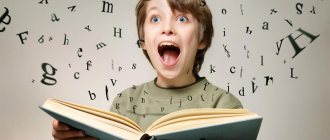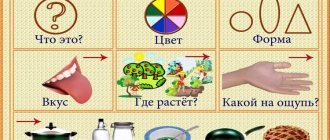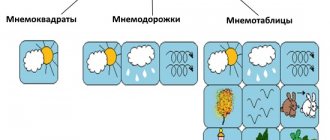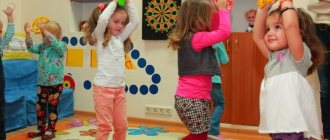Sound gymnastics for preschoolers
Ekaterina Fazleeva
Sound gymnastics for preschoolers
Sound gymnastics involves pronouncing certain sound combinations along with certain breathing techniques and performing physical exercises. sound complex increases metabolic processes in cells due to sound vibration . In addition, sound vibration improves microcirculation in the area of the pulmonary alveoli, stimulates the activity of the diaphragm, improves sputum discharge, relaxes the bronchial muscles, and increases emotional tone. In this way, the entire pulmonary system functions well, and the body better performs its protective functions. The exercises of this complex can be performed daily. They should be used most intensively in the autumn-spring period.
Before and after each exercise, a “cleansing exhalation”
pfft through pursed lips. This is where the lesson begins.
1st exercise “Kite”: I. p.: legs together, arms lowered, 1st arms raised above the head, inhale, 2nd as we exhale, lower our arms and say pfff and curl into a ball (at the same time, pronounce the letters as long as possible so that the exhalation is longer ).
When we pronounce the sound fff , all our respiratory organs relax.
Exercise 2: “Tree”. Starting position: legs together, arms down. 1 We put our right leg back on the toe, we raise our arms up (all this while inhaling slowly, 2 we lower our arms, put our leg back and say the sound mmm without opening our mouth. When we pronounce the sound mmm , this causes vibration in the chest, which increases microcirculation in the blood And immediately after this exercise, we use a cleansing exhalation fff.
In the next exercise, we use a ball, and the exercise is called “Ball Game”. I.p.: feet shoulder-width apart, we take the ball with both hands, pressing it to the chest, inhale, as we exhale we push away from ourselves and pronounce it down (we pronounce it energetically)
.
When we pronounce a sound in , we vibrate at the level of the face, this increases microcirculation in the maxillary sinuses.
Exercise 4 “Stork”. I. p.: legs together, arms down. 1, while inhaling, raise the knee of one leg and arms to the sides. As we exhale, we return to i. p. and pronounce J-R-U-H. The sound Zh needs to be pronounced longer, this increases microcirculation in the thoracic region (during bronchitis it helps to get rid of phlegm)
.
5 exercise “Helicopter” I. p.: sitting on a chair, legs together, hands on knees. 1 we move our right hand back and pronounce the sound Z-R-U-H . When we pronounce the sound Z , we increase the vibration at the level of the neck. And we always end with a cleansing exhalation F-f-f.
The sound P-f-f-f and mm-m-m is mandatory, but with the rest of the exercises you can improvise.
Breathing exercises At the preparatory stage, it is necessary to carry out exercises to develop the strength of the air stream of its direction, differentiation of the oral and.
Annual long-term plan for the integration of educational areas “Health”, “Safety”, “Music”, “Artistic work” Annual long-term plan for the integration of educational areas “Health”, “Safety”, “Music”, “Artistic work” for children.
Source
Benefits of exercise
Sound gymnastics is a series of exercises that involve pronouncing specific sounds in a certain way. This causes vibration in the vocal cords, which gradually passes into the respiratory organs and into the chest.
The purpose of sound charging is:
- Relieving bronchospasms.
- Acquiring proper breathing skills.
- Improved sputum discharge.
- Relaxation of the muscles of the bronchi.
- Normalization of microcirculation in the area of the alveoli of the lungs.
- Stimulation of the diaphragm.
- Improved mood.
- Normalization of alveolar ventilation.
- Restoring normal breathing.
Breathing exercises and sound exercises are often combined; together they will be more effective.
Card file “Respiratory and sound gymnastics” (senior group)
Suitable for both adults and children
MUNICIPAL BUDGETARY PRESCHOOL EDUCATIONAL INSTITUTION
KINDERGARTEN No. 3 IN SYCHYOVKA
"Breathing and sound gymnastics"
"The cow moos"
: on a long exhalation, pronounce “mu-u-u-u”, inhale; repeat several times.
"Play with pigeons":
on a long exhalation - “goo-goo-goo”, then sharply - “shoo!” Repeat several times.
"Locomotive
": IP: arms bent at the elbows. Walk around the bedroom, making alternating movements with your hands and saying: “Chuh-chukh-chukh-chukh” (20-30 sec).
"Rooster":
IP: stand with legs apart, arms to the sides. Clap your hands on your thighs and, exhaling, say “Ku-ka-re-ku” (4-5 times).
"The geese are hissing."
IP: feet shoulder-width apart, arms down. Lean forward while simultaneously moving your arms to the sides (bend your back, look forward) - slowly exhale with the sound “Sh-sh-sh”. Straighten up - inhale (5-6 times).
"Start of a spaceship"
: There are a few seconds left before the launch of the spacecraft, we begin to count down the time out loud in seconds - 10,9,8... Count down loudly, abruptly, in one breath without taking in air. We must try to distribute the exhaled air so that when pronouncing the word “start!”, the exhalation is free and unfettered.
"The ball burst."
IP: legs slightly apart, arms down. Raising your arms to the sides - inhale, clap in front of you - slowly exhale with the sound “sh-sh-sh-sh” (4-5 times).
“Cooking porridge.”
I.p.: o.s., one hand on the chest; the other is on the stomach. Inhale through the nose (pulling in the stomach), and exhale through the mouth, saying “sh-sh-sh” or “f-f-f” (“the porridge is boiling”) and protruding the stomach.
"Hedgehog".
I.p.: sitting, legs together, arms supported behind. Bend your knees and pull them towards your chest. Straighten your legs (“f-f-f”).
“We put on the spacesuit helmet.”
I.p. – squatting, hands clasped above your head. Inhale – i.p.; exhale - spread your arms to the sides, say: “Chick.” Repeat 4-6 times.
Breathing exercises:
1. Inflate the balloon 3-4 times. Competition between children “Who has the bigger ball?” 2. Alternate breathing through the left and right nostrils and exhaling through the mouth. Repeat 10-12 times. 3. Take a deep breath, hold your breath and exhale slowly. 4. Inhale through the nose and exhale intensely through the mouth. When exhaling, you can invite children to blow a feather or piece of paper from their palm and arrange a competition. Repeat each exercise 10-12 times.
Healthy exercises for the throat.
"Horse".
Remember how a horse's hooves clatter along the pavement. We click our tongue, now louder, now quieter. We either speed up or slow down the speed of the horse.
"Crow".
A crow sat on the fence and decided to entertain everyone with its beautiful song. First he raises his head, then he turns to the side. And her cheerful croaking can be heard everywhere. Children pronounce “ka-a-a-aar” in a drawn-out manner. Repeat 5-6 times.
« Snake's tongue."
We imagine how a long snake tongue tries to stick out as far as possible, trying to reach the chin. Repeat 6 times.
"Smiley."
The laugh got into my mouth and it was impossible to get rid of it. The eyes narrowed, the lips parted joyfully, and the sounds of “ha-ha-ha, hee-hee-hee, gee-gee-gee” were heard.
Breathing game
“King of the Winds”.
Place 5-10 balls on the table between the pencils. Having stretched out his lips with a tube, with a deep, strong exhalation, the child needs to blow the balls off the table one at a time. Inhale through your nose.
"Woodcutter".
IP: feet shoulder-width apart, arms along the body. Raise your clasped hands up - inhale, lower them down - long exhale with the pronunciation “Uh-h-h” (5-6 times).
“Hug your shoulders.”
I.p.: o.s., arms are bent at the elbows and raised to shoulder level with the hands facing each other. At the moment of a short noisy inhalation through the nose, we throw our hands towards each other, as if hugging ourselves by the shoulders.
"Tiger on the hunt."
Walking around the site, put your right (left) leg forward, place your two hands with your palms on your knee, arching your back. Take two to four sharp breaths, head raised (“tiger is looking for prey”).
"Balloons".
Perform while walking around the site. 1 - arms to the sides, up, inhale through the nose, clap your hands (“the ball burst”); 2 - arms to the sides, down, saying “s-s-o” or “sh-sh-sh” (“the ball has gone down”).
"Fungus".
IP: deep squat, hands clasping knees (“small fungus”). Slowly straighten up, spreading your arms to the sides, move your head back a little (inhale) (“the fungus has grown”).
"Crane".
I.p.: o.s. Inhale, raise your right leg, slightly bent at the knee, arms to the sides, down, say “ur-r-r.” Do the same with your left foot.
“Here is a tall pine tree standing and moving its branches.”
I.p.: o.s. 1—inhale—arms to the sides; 2 - exhale - tilt the body to the right; 3 - inhale - return to the first position; 4 - the same to the left.
"Meadow Flowers"
While walking along the platform (hands on your belt), turn your head to the right (left) side, while simultaneously taking two breaths through your nose. Exhalation occurs between cycles of turning the head in one direction or another.
Sound exercises
It is best to do gymnastics while sitting, placing your hands on your knees and leaning slightly forward. Take your time, stick to your rhythm, remember to breathe correctly during the exercises:
- The sound "a". Its pronunciation helps improve the ventilation function of the lungs and the effective functioning of the respiratory muscles.
- The "u" sound. Has a calming effect and leads to relaxation.
- Slowly pronouncing in a whisper the sounds “a”, “o”, “u”, “e” and the short words “dry” and “deaf” has a calming effect on the upper respiratory tract and helps cleanse the vocal cords.
- When combining “kch”, “dg”, “bp”, “kg”, mucus removal improves and the throat muscles relax.
- The buzzing sounds “zh” and “z” and the growling “r”, when pronounced loudly, give the effect of a vibration massage, while relaxing the bronchial muscles.
- For your child, you can offer to imitate the sounds of a beetle “zh-zh-zh”, a train “chug-chug”, a mosquito “pi-i” and an airplane “oo-oo-oo”.
- The use of hissing and whistling “s”, “f”, “ts”, “ch”, “sh” in gymnastics accelerates the removal of air from the lungs, and this prevents emphysema. It is better to inhale through your nose and exhale through your mouth, drawing in your stomach.
- For older children and adults, you need to do the obligatory “pf-f-f” exercise once. Its peculiarity is that the combination of these sounds is pronounced with tightly compressed lips. This is considered a cleansing exercise. After doing this, pause, take a breath and pause again. If the exercise is performed by a child, an adult can stand behind him during the exercise and move his palms from the lower back up to the sides, stopping in the middle of the baby’s sides when the exhalation ends. This is done to make breathing easier.
- Next, pronounce the sound “mm-mm” while exhaling; it should be drawn-out, wave-like and relaxed. This exercise is done 5-7 times.
- A combination of the sounds “zhzhruh”, “zrukhh”, “brukhh” and “prrukh” will be useful for relieving bronchospasm.
Each workout can be increased by two new exercises. It is optimal to conduct a lesson for 5 minutes, then increase to 7–10 minutes. Maximum 2 repetitions per day. If a child complains of shortness of breath after sound exercises, it is necessary to do a light massage of the lower chest, over the clothes.
With proper and regular exercise, relief from bronchospasm will occur faster and a long-awaited improvement will appear.
Special techniques of breathing exercises
Sound gymnastics
Sound gymnastics consists of pronouncing certain sounds and their combinations in a strictly defined way, while the vibration of the vocal cords is transmitted to the smooth muscles of the bronchi, lungs, and chest, relaxing the spasmodic bronchi and bronchioles. The strength of vibration depends on the strength of the air stream that occurs when pronouncing certain sounds; this fact is used to train the respiratory muscles, most of all the diaphragm.
Depending on the strength of the air stream and vibration, all consonant sounds are divided into three groups:
- maximum tension occurs when pronouncing voiceless consonants (p, t, k, f, s); accordingly, the greatest tension in the muscles of the chest and diaphragm is required;
- medium-strength tension develops when pronouncing voiced consonants (b, d, d, c, h);
- The lowest force of the air stream occurs when pronouncing the so-called sonants (m, n, l, p).
Special consonants:
- buzzing (f, h);
- whistling and hissing (s, f, c, ch, w);
- growling (r).
The task of sound gymnastics is to develop a 1:2 ratio of inhalation and exhalation.
Indications for sound gymnastics:
- respiratory tract diseases accompanied by bronchospasm;
- bronchial asthma;
- obstructive bronchitis.
When performing sound gymnastics exercises, it is important to breathe correctly:
- inhale through the nose, duration 1-2 seconds, pause 1 second, active exhalation through the mouth 2-4 seconds, pause 4-6 seconds. The exhalation should be twice as long as the inhalation. With this ratio of respiratory movements, the most complete gas exchange occurs in the alveoli and complete mixing of inhaled air with alveolar air;
- all sounds should be pronounced in a strictly defined way, depending on the purpose of the gymnastics;
- with bronchial asthma, buzzing, growling, hissing sounds are pronounced loudly, energetically, “excitingly”;
- in case of chronic obstructive bronchitis with severe respiratory failure, the same sounds are pronounced softly, quietly, perhaps in a whisper, “calmingly”;
- The lesson begins with a “cleansing exhalation”: “pfft” is pronounced through pursed lips;
- a “cleansing exhalation” is performed before and after each sound exercise;
- the second mandatory exercise is the “closed groan”: “mmm” is pronounced while sitting, leaning forward, placing your hands on your knees, palms down;
- when performing complexes of sound exercises, gymnastic exercises should be gradually introduced after 2-3 sessions;
- Duration of classes: at first 5-6 minutes, then gradually increases, but no more than 25-30 minutes 2-3 times a day;
- It is advisable to conduct classes before meals or 1.5-2 hours after meals.








